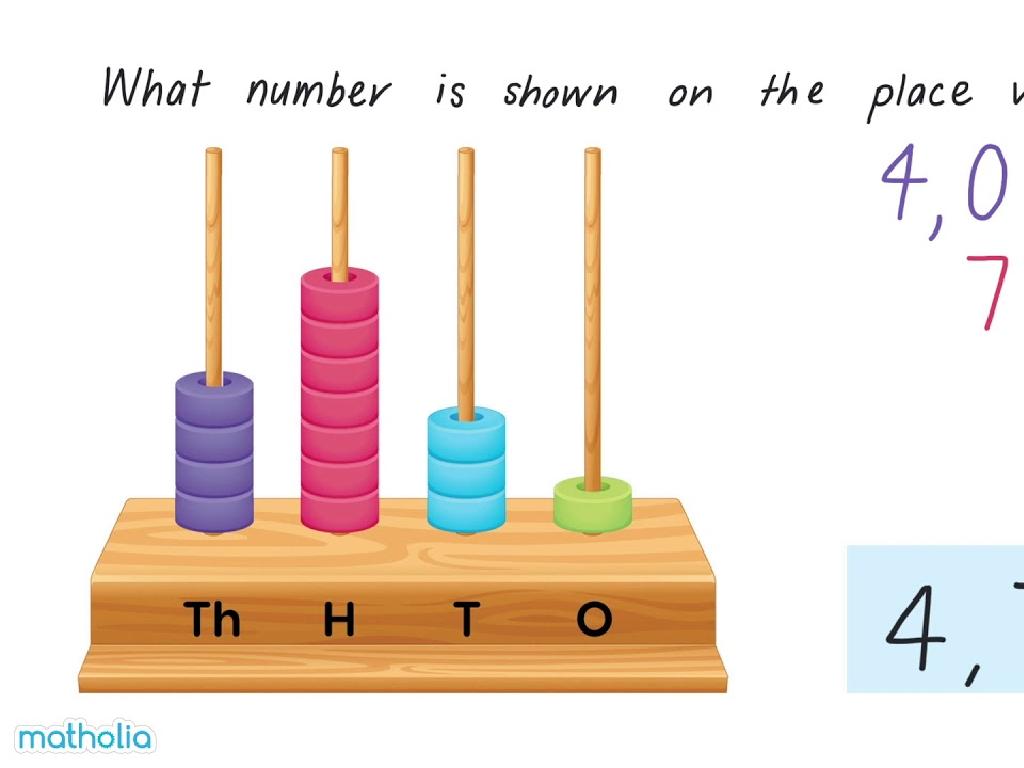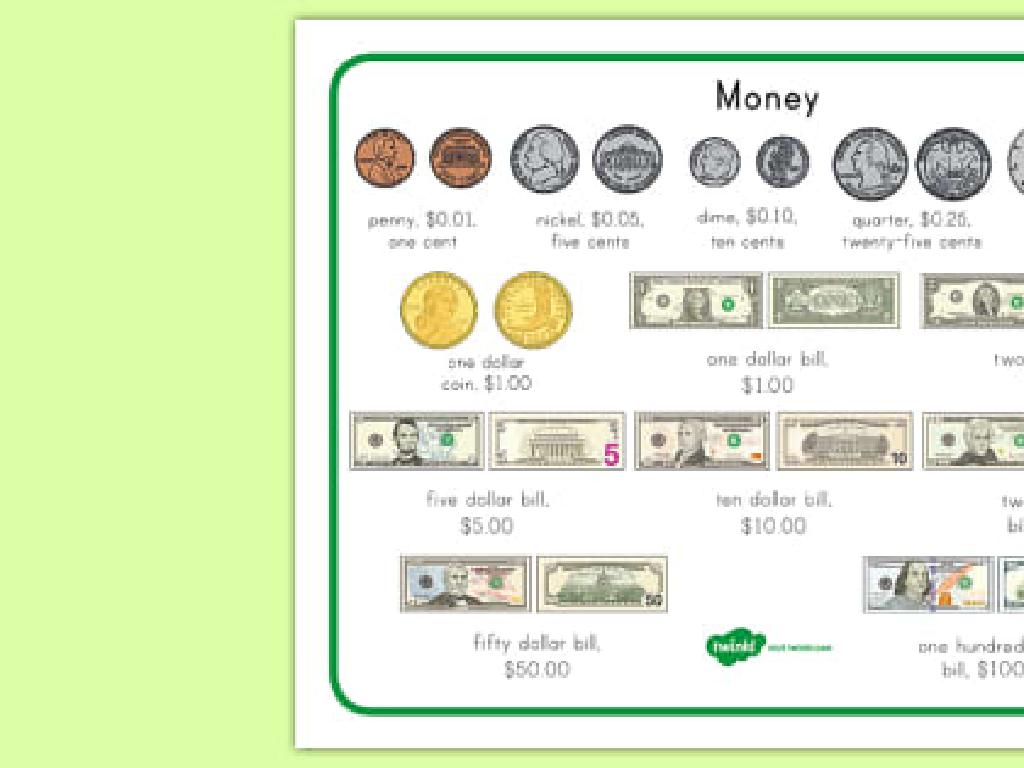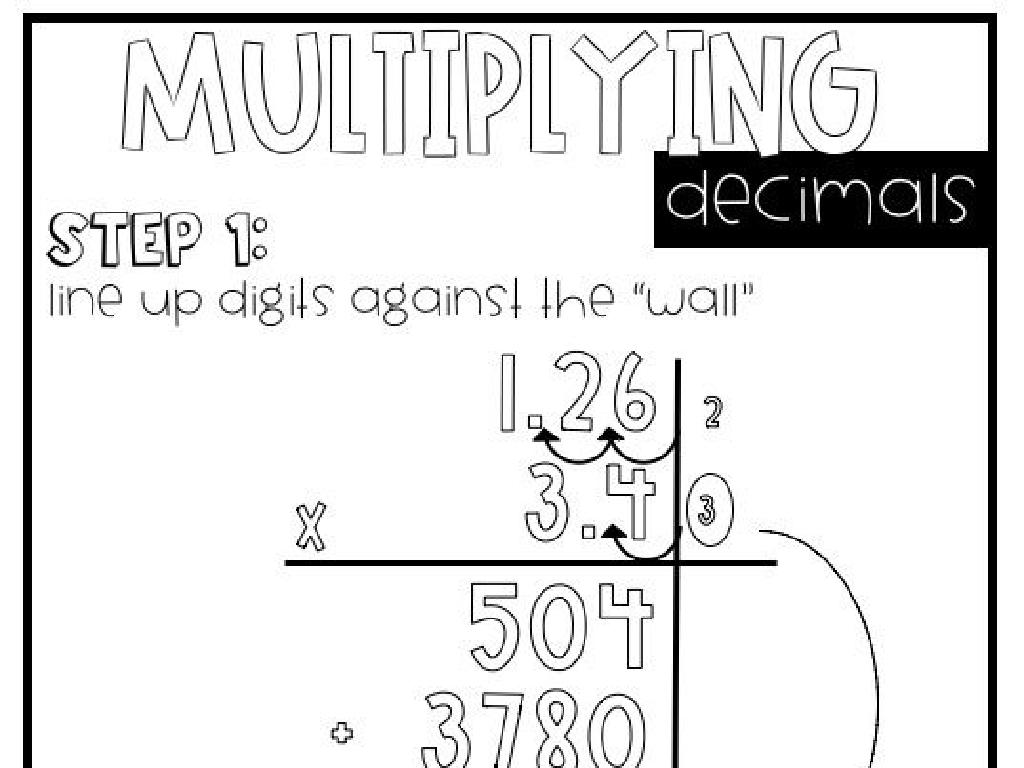Write Addition And Subtraction Sentences
Subject: Math
Grade: Second grade
Topic: Mixed Operations: Two Digits
Please LOG IN to download the presentation. Access is available to registered users only.
View More Content
Introduction to Mixed Operations
– Learning addition and subtraction
– Why combining numbers is useful
– Helps with daily tasks like shopping
– Using two-digit numbers
– Numbers like 23, 58, or 76
– Creating math sentences
– Examples: 34 + 15 = ?, 60 – 22 = ?
|
This slide introduces second graders to the concept of mixed operations with a focus on addition and subtraction using two-digit numbers. Emphasize the practicality of these skills in everyday situations such as shopping or sharing. Use visual aids or manipulatives like blocks or counters to help students visualize the combination and separation of numbers. Encourage them to think of numbers in terms of tens and ones to simplify the process. Provide clear examples of how to construct and solve addition and subtraction sentences, and prepare to guide them through practice problems in class.
Understanding Addition Sentences
– What is an addition sentence?
– It’s a way to show combining numbers to make a total.
– Example: 23 + 15 = 38
– See how 23 and 15 combine to make 38?
– ‘Addends’ are numbers we add
– The ‘sum’ is the result
|
This slide introduces the concept of addition sentences to second-grade students. Start by explaining that an addition sentence is a mathematical expression that shows how two or more numbers are combined to make a new total. Use the example provided to illustrate this concept. Clarify the terminology by explaining that the numbers being added together are called ‘addends’ and the final result is known as the ‘sum’. Encourage students to think of addition as bringing things together to find out how many there are in total. To reinforce the concept, you can use visual aids like counters or blocks to physically demonstrate the addition process.
Creating Our Own Addition Sentences
– Make addition sentences
– Line up numbers by place value
– Ensure the ones and tens are in the correct columns
– Start with the ones place
– If 3 + 2 in the ones place equals 5, write ‘5’ in the ones place
– Add the tens place next
– For 40 + 20, write ’60’ in the tens place
|
This slide is aimed at helping second-grade students understand how to construct addition sentences with two-digit numbers. Emphasize the importance of place value by lining up the ones and tens correctly. Use examples on the board to demonstrate starting with the ones place when adding. Show that after adding the ones place, they should move to the tens place. Encourage students to practice with different numbers and provide guidance as needed. Possible activities include using manipulatives like blocks or drawings to visually represent the addition process, and pairing students to create and solve their own addition problems.
Understanding Subtraction Sentences
– Subtraction sentences explained
– Shows taking away one number from another
– Example: 46 – 29 = 17
– Here, 29 is taken away from 46, leaving 17
– Terms: ‘minuend’, ‘subtrahend’, ‘difference’
– Minuend is the starting number, subtrahend is what we take away, and the result is the difference
|
This slide introduces the concept of subtraction sentences to second-grade students. Begin by explaining that subtraction is like taking away parts from a whole. Use the example provided to illustrate how subtraction works and introduce the terms ‘minuend’, ‘subtrahend’, and ‘difference’. Make sure to use visual aids or props to help students visualize the concept. Encourage students to think of subtraction as a story where they have a certain number of items and then some are taken away. After the explanation, give students simple subtraction problems to practice writing their own subtraction sentences.
Creating Our Own Subtraction Sentences
– Crafting subtraction sentences
– Subtracting with place values
– Ensure smaller numbers are subtracted from larger ones
– Borrowing from the tens place
– If the top number is smaller, borrow 1 from the next left place value
– Practice with examples
– Use simple two-digit numbers to demonstrate borrowing
|
This slide is aimed at teaching students how to create their own subtraction sentences with two-digit numbers. Emphasize the importance of aligning numbers by their place values and carefully subtracting the ones before the tens. Explain the concept of borrowing, where if the number in the ones place of the minuend (the number being subtracted from) is smaller than the subtrahend (the number being subtracted), they need to borrow from the tens place. Provide clear examples, such as 52 – 29, showing step by step how to borrow. Encourage students to practice with different numbers and prepare a few exercises where they can apply this concept. This will help solidify their understanding of subtraction across place values.
Mixed Operations: Addition & Subtraction
– Mix addition and subtraction
– Solve problems as a class
– We’ll do some examples on the board together
– Clues in word problems
– Words like ‘total’ or ‘in all’ might mean add; ‘left’ or ‘fewer’ might mean subtract
– Choosing to add or subtract
|
This slide is aimed at helping second-grade students understand how to write and solve mixed operation math sentences involving both addition and subtraction. Start by explaining that math problems can have both types of operations. Work through problems on the board as a class to demonstrate how to solve them. Teach students to look for keywords in word problems that indicate whether to add or subtract. For example, ‘total’ or ‘in all’ suggest addition, while ‘left’ or ‘fewer’ suggest subtraction. Encourage students to think about what the problem is asking to determine the correct operation. Provide several examples and guide students through the thought process of choosing the right operation for each problem.
Math Scavenger Hunt: Addition & Subtraction
– Explore the classroom on a scavenger hunt
– Find objects to write math sentences
– For example, if you find 4 pencils and 3 erasers, write: 4 + 3 = 7
– Work in pairs for the hunt
– Use math skills on your hunt sheet
– Solve problems like 7 – 2 if you had 7 items and gave 2 away
|
This interactive class activity is designed to help students apply their addition and subtraction skills in a fun and engaging way. Set up the classroom with various objects that students can count. Provide each pair with a ‘hunt sheet’ where they can record their findings and write corresponding addition or subtraction sentences. Encourage them to think creatively and work collaboratively. As they find items, they should discuss and decide whether to create an addition or subtraction sentence based on their findings. Offer guidance as needed and ensure that each pair participates equally. Possible activities: counting books and subtracting those that are red, adding the number of chairs to the number of tables, or finding a group of items and taking some away to write a subtraction sentence.
Conclusion & Homework: Practice Time!
– Excellent work on addition & subtraction!
– Complete the worksheet for homework.
– Try to solve each problem and check your work.
– Practice with different two-digit numbers.
– Use the strategies we learned to add and subtract.
– Get ready to discuss scavenger hunt.
– We’ll go over the scavenger hunt answers in class.
|
Today’s lesson focused on writing addition and subtraction sentences with two-digit numbers. For homework, students are assigned a worksheet to reinforce the concepts learned. Encourage them to use the strategies taught in class, such as stacking numbers and using number lines. Remind them that practice is essential for mastering these skills. Prepare for tomorrow’s class by reviewing the scavenger hunt activity, ensuring you’re ready to discuss the answers and the reasoning behind them. This will help students understand the practical application of the operations.






